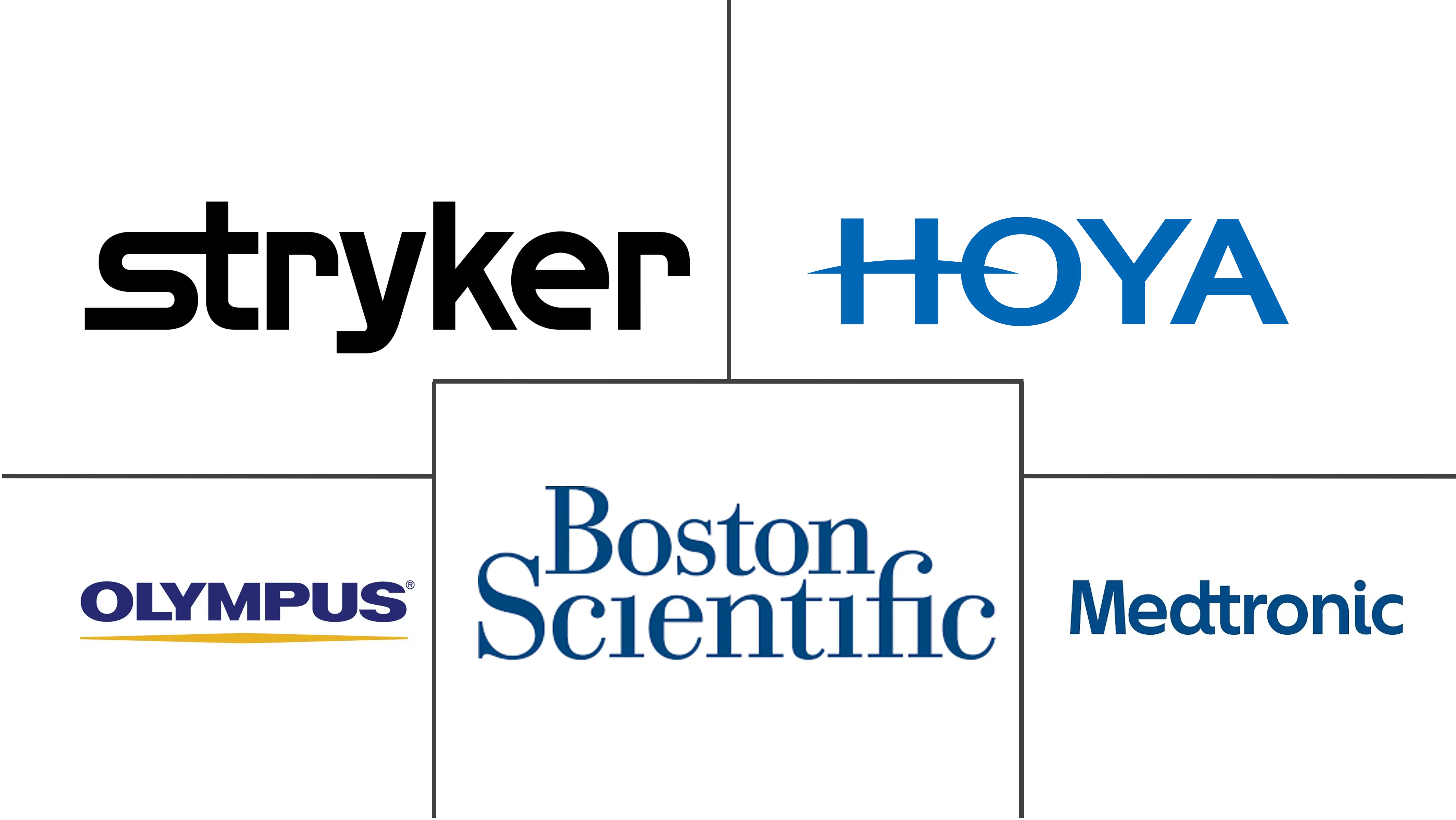
Minimally Invasive Surgery Devices Market Analysis by Mordor Intelligence
The Minimally Invasive Surgery Devices Market size is estimated at USD 36.52 billion in 2025, and is expected to reach USD 50.21 billion by 2030, at a CAGR of 6.59% during the forecast period (2025-2030).
Robust demand reflects the continuing shift away from traditional open surgery toward precision-guided treatments that shorten recovery times and lower complication rates. Accelerating adoption of robotic platforms, stronger reimbursement support for outpatient interventions, and rapid technology convergence around artificial intelligence are pivotal forces shaping this growth. Handheld instruments continue to serve as the procedural workhorse, yet robotic systems are scaling quickly as hospitals seek workflow efficiencies and differentiation. Emerging single-port systems, AI-assisted visualization suites, and pulsed-field ablation devices illustrate how continual innovation is widening clinical possibilities while expanding addressable patient pools. As payors reward surgical settings that reduce inpatient days, ambulatory centers gain momentum, further enlarging the minimally invasive surgery devices market.
Key Report Takeaways
- By product type, handheld instruments led with 38.12% of minimally invasive surgery devices market share in 2024, while robotic-assisted systems are projected to post the fastest 9.47% CAGR through 2030.
- By application, orthopedic procedures commanded 24.81% share of the minimally invasive surgery devices market size in 2024, and neurological applications are forecast to expand at a 7.91% CAGR through 2030.
- By end user, hospitals accounted for 54.31% share of the minimally invasive surgery devices market size in 2024, whereas ambulatory surgical centers are on track for a 9.05% CAGR to 2030.
- By geography, North America held 42.41% of minimally invasive surgery devices market share in 2024, and Asia Pacific represents the fastest-growing region at a 10.15% CAGR up to 2030.
Global Minimally Invasive Surgery Devices Market Trends and Insights
Drivers Impact Analysis
| Driver | (~) % Impact on CAGR Forecast | Geographic Relevance | Impact Timeline |
|---|---|---|---|
| Higher acceptance of MIS over open surgery | +1.8% | Global | Medium term (2-4 years) |
| Rising prevalence of chronic & lifestyle diseases | +1.5% | Global, developed markets | Long term (≥ 4 years) |
| Rapid adoption of robotic-assisted platforms | +2.1% | North America & Europe, expanding to APAC | Short term (≤ 2 years) |
| Reimbursement tweaks favoring outpatient MIS | +1.2% | North America & EU | Medium term (2-4 years) |
| AI-guided visualization improving surgical accuracy | +0.8% | North America & Europe | Long term (≥ 4 years) |
| Demand for single-port & natural-orifice MIS | +0.7% | Global, early adoption in developed markets | Medium term (2-4 years) |
| Source: Mordor Intelligence | |||
Higher Acceptance of MIS Over Open Surgery
Growing patient advocacy for less traumatic care, hospital mandates that prioritize MIS-first protocols, and payor incentives are accelerating adoption. Boston Scientific’s FARAPULSE pulsed-field ablation system surpassed USD 1 billion in revenue within 12 months of launch, underscoring appetite for technologies that reduce procedural complexity while preserving outcomes.[1]Boston Scientific, “FARAPULSE Pulsed Field Ablation System Surpasses USD 1 Billion,” bostonscientific.com The shift is most pronounced in cardiac rhythm management, where pulsed-field energy offers selective tissue targeting and lower complication rates than thermal modalities. Institutions are seeing bed-utilization efficiencies and readmission reductions that further solidify MIS preference. Insurers now routinely provide favorable coverage terms for minimally invasive interventions, aligning economic and clinical rationales. As training curricula reposition MIS competencies as core skills, the minimally invasive surgery devices market gains a durable foundation for long-term growth.
Rising Prevalence of Chronic & Lifestyle Diseases
Global incidence of diabetes, cardiovascular disorders, and obesity is elevating surgical volumes suitable for less invasive solutions. Abbott’s FDA-approved Tendyne transcatheter mitral valve replacement treats patients unfit for open surgery, opening a sizeable niche in structural heart interventions.[2]Abbott Laboratories, “Tendyne Transcatheter Mitral Valve Replacement Cleared by FDA,” abbott.com Atrial fibrillation affects 33.5 million people worldwide, creating sustained demand for catheter-based ablation systems that offer definitive therapy without sternotomy. Single-port bariatric techniques are expanding eligibility for weight-loss surgery by lowering postoperative pain and improving recovery times. As healthcare systems pivot from reactive to preventive care, minimally invasive devices are positioned as cost-effective tools that curb chronic disease burdens. The resulting procedural growth underpins incremental gains in the minimally invasive surgery devices market.
Rapid Adoption of Robotic-Assisted Platforms
Robotics are diffusing beyond laparoscopic mainstays into orthopedics, neurology, and spine. Zimmer Biomet’s ROSA Shoulder System completed the first robotic-assisted shoulder arthroplasty in 2024, illustrating the technology’s widening reach.[3]Zimmer Biomet, “First Robotic-Assisted Shoulder Arthroplasty Using ROSA,” zimmerbiomet.com Artificial intelligence layers predictive analytics onto robotic controls, shortening learning curves and standardizing outcomes. Karl Storz’s 2024 purchase of Asensus Surgical highlighted strong strategic interest in next-generation platforms. Single-port architectures offer smaller incisions while preserving dexterity, amplifying patient appeal. Institutions justify capital outlays through surgeon retention, fewer complications, and higher patient satisfaction scores, accelerating momentum for the minimally invasive surgery devices market.
AI-Guided Visualization Improving Surgical Accuracy
Machine-learning algorithms now overlay imagery with anatomy-aware guidance, boosting accuracy in implant placement, tumor margins, and vascular navigation. Zimmer Biomet’s 2024 acquisition of OrthoGrid embeds AI within intraoperative imaging, trimming hip-replacement revision rates and lengthening implant lifespan. Computer vision integrated into endoscopes automates lesion detection, aiding early diagnosis. Cloud-based analytics produce continuous software upgrades that create recurring revenue streams. Simulation platforms use AI feedback to accelerate trainee proficiency, thereby easing surgeon shortages. This convergence of AI and visualization capabilities is a powerful catalyst for the minimally invasive surgery devices market.
Restraints Impact Analysis
| Restraint | (~) % Impact on CAGR Forecast | Geographic Relevance | Impact Timeline |
|---|---|---|---|
| Shortage of skilled MIS surgeons | -1.4% | Global, acute in emerging markets | Long term (≥ 4 years) |
| Capital-intensive robotic systems | -0.9% | Emerging markets, smaller health systems | Medium term (2-4 years) |
| Supply-chain fragility for key disposables | -0.6% | Global | Short term (≤ 2 years) |
| Cyber-security risks in connected OR suites | -0.3% | Developed markets | Medium term (2-4 years) |
| Source: Mordor Intelligence | |||
Shortage of Skilled MIS Surgeons
Advanced robotic and single-port techniques require 50–100 supervised cases for proficiency, a hurdle that slows adoption even where hardware is available. Emerging markets experience pronounced shortages as surgeon migration toward higher-income regions erodes local capacity. Simulation programs, remote mentoring, and augmented reality guidance mitigate but do not eliminate skills gaps. Policy initiatives that fund fellowship programs are expanding, yet the time lag to produce fully trained specialists remains a structural brake on the minimally invasive surgery devices market.
Capital-Intensive Robotic Systems
Initial purchase prices, annual service contracts, and disposable instrument costs often exceed USD 2 million over a system’s first five years. Smaller hospitals and ambulatory centers weigh these costs against uncertain procedure volumes and reimbursement ceilings. Cybersecurity protections add extra expense; ransomware has disrupted elective surgery schedules and forced costly downtime. Leasing models and outcome-based financing are emerging, yet many providers remain cautious, dampening penetration rates for high-end robotic suites within the minimally invasive surgery devices industry.
Segment Analysis
By Product Type: Robotics Surge Challenges Handheld Dominance
Handheld instruments continued to command the largest portion of the minimally invasive surgery devices market size, generating 38.12% of revenue in 2024. Their ubiquity across laparoscopy, endoscopy, and catheter-based procedures ensures resilience even as new modalities arise. Conversely, robotic-assisted systems, though smaller in absolute value, are forecast to post a 9.47% CAGR, the swiftest in the category, as hospitals leverage their precision and ergonomic benefits to tackle complex surgeries. Guiding devices such as catheters and guidewires remain indispensable, providing steady incremental growth. Electrosurgical platforms are migrating to advanced energy sources that seal vessels more reliably, and ablation devices are shifting toward pulsed-field technologies that minimize collateral tissue damage.
Market entrants are funneling investment into single-port robotics, positioning these systems to erode dependence on multi-port configurations favored by handheld tools. AI-linked 4K and 8K visualization upgrades rejuvenate legacy laparoscopes, extending their lifespan while elevating diagnostic accuracy. Ablative lasers are finding traction in precise tissue removal for ENT and gynecologic procedures, expanding the addressable space of the minimally invasive surgery devices market. As technology cycles quicken, the product mix will continue to tilt toward software-enhanced hardware, yet core mechanical instruments will preserve relevance through affordability and familiarity.
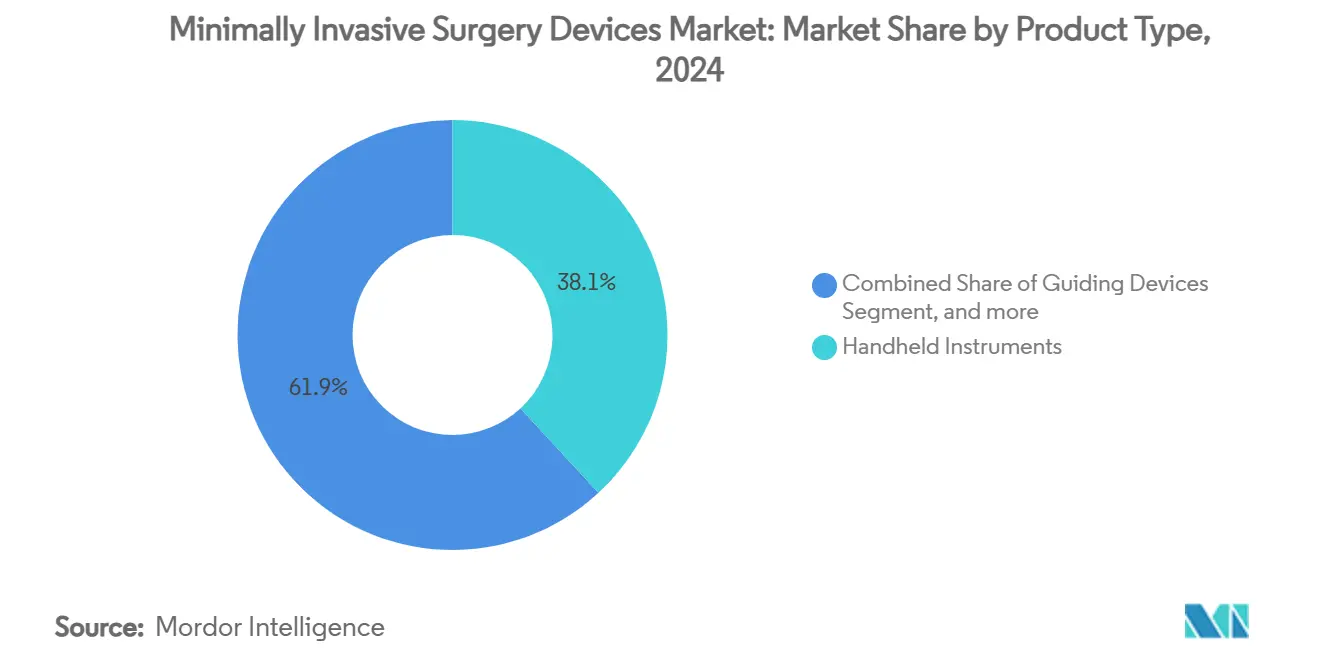
Note: Segment shares of all individual segments available upon report purchase
By Application: Neurological Procedures Accelerate Beyond Orthopedic Leadership
Orthopedic surgery has long epitomized MIS maturity, retaining a 24.81% share of the minimally invasive surgery devices market size in 2024 on the strength of knee, hip, and spine adaptations. High reimbursement certainty and abundant clinical evidence sustain utilization. Neurological procedures, however, are on pace for a 7.91% CAGR as AI-guided navigation enables safe tumor resections and robotic catheters traverse tortuous cerebral vasculature with millimeter accuracy. Cardiovascular interventions extend transcatheter techniques into structural heart disease, while gastrointestinal endoscopy integrates AI polyp detection to elevate adenoma-detection rates.
Cross-fertilization among specialties is rising. Robotic arms initially conceived for prostatectomy now support transforaminal lumbar fusion, indicating convergent device design. Aesthetic and bariatric segments, once peripheral, exploit single-port laparoscopy to reduce scarring and accelerate ambulation, thereby broadening the revenue horizon within the minimally invasive surgery devices market. Continued diversification of clinical indications is expected to balance growth between legacy orthopedic volumes and emerging neurological demand.
By End User: ASCs Challenge Hospital Dominance
Hospitals delivered 54.31% of global revenue in 2024 through comprehensive service offerings and procedural breadth. Their integrated intensive-care capabilities remain essential for high-risk patients, ensuring hospitals’ central role in the minimally invasive surgery devices market. Nonetheless, ambulatory surgical centers are tracking a 9.05% CAGR, benefitting from shorter scheduling queues, lower facility fees, and expanding payor approval for outpatient versions of formerly inpatient procedures. Specialty clinics are carving out niches in ophthalmology, ENT, and pain management where focused volume yields superior efficiencies.
Anesthetic advances that facilitate same-day discharge augment ASC competitiveness. Vendors such as Zimmer Biomet now customize capital-equipment packages for ambulatory settings, bundling robotic rental models, disposables, and staff training to lower adoption thresholds. Hospitals counter with satellite outpatient wings, blending ASC convenience with immediate escalation capabilities. Regulatory shifts, including CMS expansions of outpatient-eligible procedure codes, continue to tilt volume toward decentralized sites, redefining channel strategy for manufacturers within the minimally invasive surgery devices market.
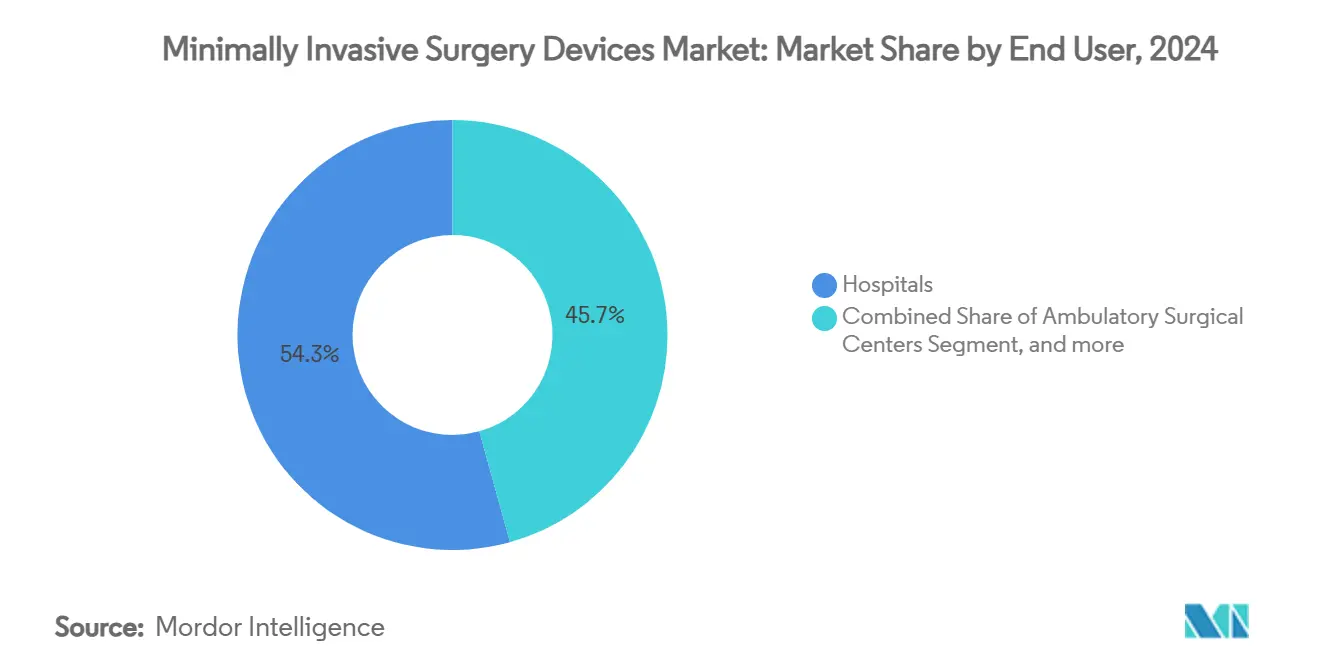
Note: Segment shares of all individual segments available upon report purchase
Geography Analysis
North America maintained 42.41% of global revenue in 2024, underpinned by robust reimbursement, advanced training pipelines, and rapid regulatory pathways that shorten time-to-market for breakthrough devices. Consolidating health systems negotiate enterprise-wide procurement contracts, granting leading suppliers scalable access across multistate hospital networks. The aging demographic and high chronic-disease prevalence underpin steady procedural expansion, while academic centers pioneer novel techniques that diffuse into community settings.
Asia Pacific represents the fastest-growing territory, advancing at a 10.15% CAGR through 2030, fueled by capacity additions, rising middle-class incomes, and government promotion of medical tourism. China fosters domestic innovation while partnering with global device firms to spur technology transfer. India’s cost-sensitive market turns to value-engineered platforms, often refurbishing Western systems to meet price points. Japan deploys premium robotic solutions to address surgeon shortages and accommodate an aging populace. Korea leverages state-of-the-art hospitals to attract international patients seeking aesthetic and spinal procedures.
Europe’s stringent MDR framework fosters high product quality but lengthens approval cycles, requiring robust clinical dossiers. Germany remains a manufacturing stronghold, and the United Kingdom’s NHS provides large-scale data sets that facilitate evidence generation. Middle East and Africa, though nascent, are investing in flagship tertiary centers, particularly in GCC nations that seek to reduce outbound medical travel. Latin America shows uneven adoption; Brazil’s public–private mix sustains progress despite macroeconomic volatility. Collectively, regional heterogeneity compels suppliers to adopt nuanced entry strategies that safeguard compliance while scaling the minimally invasive surgery devices market.
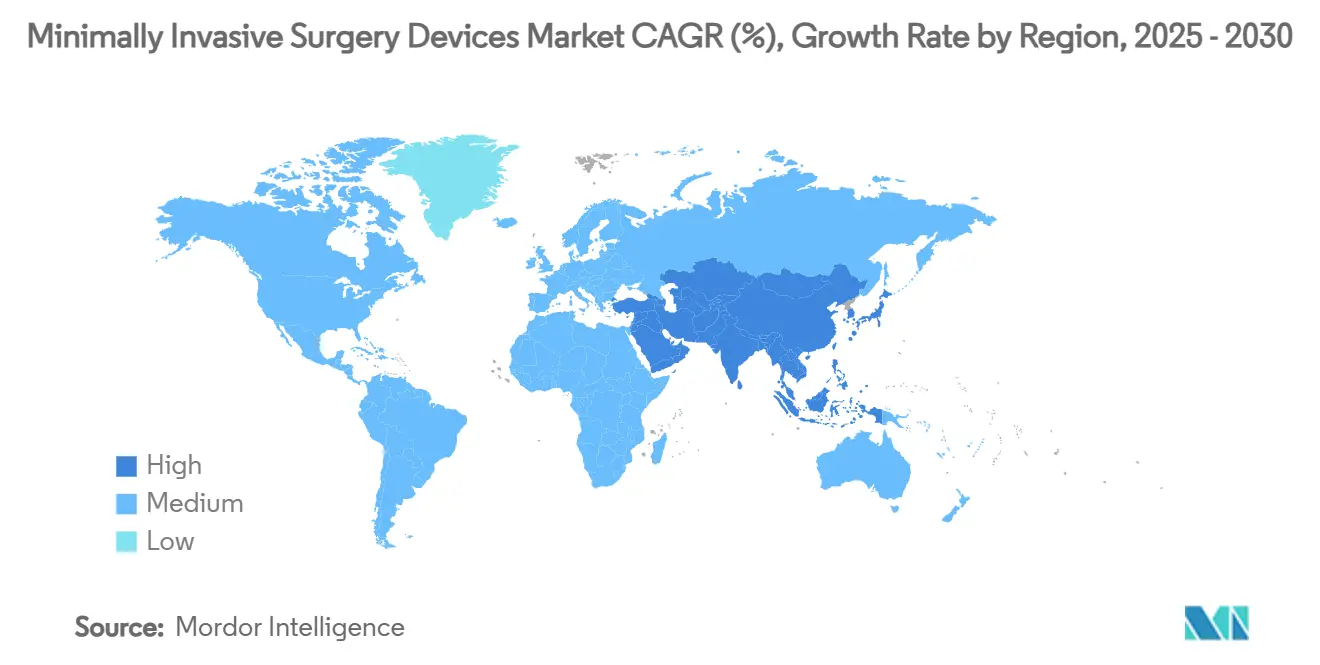
Competitive Landscape
The market is moderately fragmented with leading multinationals deploy scale to fund R&D, pursue acquisitions, and negotiate group purchasing contracts. Intuitive Surgical pioneers multi-port robotics, but challengers including Medtronic, Zimmer Biomet, and Johnson & Johnson are fielding rival platforms, intensifying price and feature competition. Cybersecurity now ranks alongside precision as a differentiator, with hospital CIOs demanding encrypted data pipelines and zero-trust architectures for connected OR suites.
AI software add-ons are creating sticky ecosystems that lock customers into vendor-specific disposables and analytics subscriptions, driving recurring revenue beyond the initial capital sale. Smaller firms carve out niches through single-use endoscopes, pulsed-field generators, and chip-on-tip camera modules, often exiting via trade-sale to larger strategics eager to plug portfolio gaps. Strategic collaborations with cloud providers accelerate algorithm deployment, while contract manufacturers in Asia enable cost-optimization. Heightened due diligence follows supply-chain shocks, prompting component diversification to safeguard production. The net result is a race to integrate robotics, visualization, and data analytics into unified platforms that extend the minimally invasive surgery devices market footprint.
Minimally Invasive Surgery Devices Industry Leaders
-
Olympus Corporation
-
Stryker Corporation
-
HOYA Corporation
-
Medtronic
-
Boston Scientific Corporation
- *Disclaimer: Major Players sorted in no particular order
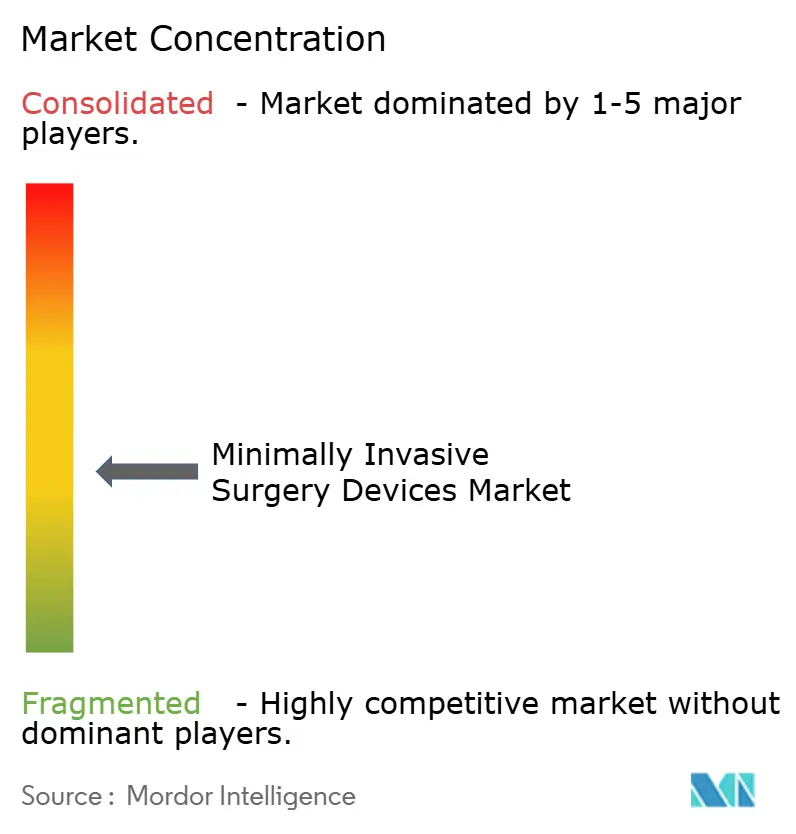
Recent Industry Developments
- July 2025: Boston Scientific received FDA approval for expanded labeling of the FARAPULSE Pulsed Field Ablation System to include treatment for persistent atrial fibrillation, potentially doubling the addressable patient population to 59 million people worldwide and reinforcing the company's leadership in cardiac ablation technologies.
- July 2025: Teleflex completed the acquisition of BIOTRONIK's Vascular Intervention business for EUR 760 million (USD 825 million), significantly expanding its interventional portfolio with drug-coated balloon catheters and stents while establishing a strong presence in the peripheral intervention market.
- May 2025: Abbott received FDA approval for the Tendyne transcatheter mitral valve replacement system, the first device capable of replacing mitral valves without open-heart surgery, addressing a significant unmet need for patients with severe mitral annular calcification.
- January 2025: Zimmer Biomet announced its agreement to acquire Paragon 28 for approximately USD 3 billion, enhancing its portfolio in the USD 5 billion foot and ankle segment and supporting its strategy to diversify beyond core orthopedics into higher-growth markets.
Global Minimally Invasive Surgery Devices Market Report Scope
As per the scope of this report, minimally invasive surgical devices refer to electrosurgical systems, robot-assisted surgical systems, and surgical equipment used during minimally invasive procedures. Minimally invasive surgery refers to any surgical procedure performed through tiny incisions instead of a large opening, leading to quicker recovery, minimal blood loss, and less pain than traditional open surgery.
The minimally invasive surgery devices market is segmented by product (handheld instruments, guiding devices, electrosurgical devices, endoscopic devices, laparoscopic devices, monitoring and visualization devices, ablation devices, laser-based devices, robotic-assisted surgical systems, and other MIS devices), application (aesthetic, cardiovascular, gastrointestinal, gynecological, orthopedic, urological, and other applications), and geography (North America, Europe, Asia-Pacific, Middle-East and Africa, and South America). The market report also covers the estimated market sizes and trends for 17 countries across major regions globally. The report offers the value (in USD million) for all the above segments.
| Handheld Instruments | |
| Guiding Devices | Guiding Catheters |
| Guidewires | |
| Electrosurgical Devices | |
| Endoscopic Devices | |
| Laparoscopic Devices | |
| Monitoring & Visualization Devices | |
| Ablation Devices | |
| Laser-based Devices | |
| Robotic-assisted Surgical Systems | |
| Other MIS Devices |
| Aesthetic |
| Cardiovascular |
| Gastrointestinal |
| Gynecological |
| Orthopedic |
| Urological |
| Neurological |
| Other Applications |
| Hospitals |
| Ambulatory Surgical Centers |
| Specialty Clinics |
| North America | United States |
| Canada | |
| Mexico | |
| Europe | Germany |
| United Kingdom | |
| France | |
| Italy | |
| Spain | |
| Rest of Europe | |
| Asia Pacific | China |
| Japan | |
| India | |
| Australia | |
| South Korea | |
| Rest of Asia-Pacific | |
| Middle East & Africa | GCC |
| South Africa | |
| Rest of Middle East & Africa | |
| South America | Brazil |
| Argentina | |
| Rest of South America |
| By Product Type | Handheld Instruments | |
| Guiding Devices | Guiding Catheters | |
| Guidewires | ||
| Electrosurgical Devices | ||
| Endoscopic Devices | ||
| Laparoscopic Devices | ||
| Monitoring & Visualization Devices | ||
| Ablation Devices | ||
| Laser-based Devices | ||
| Robotic-assisted Surgical Systems | ||
| Other MIS Devices | ||
| By Application | Aesthetic | |
| Cardiovascular | ||
| Gastrointestinal | ||
| Gynecological | ||
| Orthopedic | ||
| Urological | ||
| Neurological | ||
| Other Applications | ||
| By End User | Hospitals | |
| Ambulatory Surgical Centers | ||
| Specialty Clinics | ||
| By Geography | North America | United States |
| Canada | ||
| Mexico | ||
| Europe | Germany | |
| United Kingdom | ||
| France | ||
| Italy | ||
| Spain | ||
| Rest of Europe | ||
| Asia Pacific | China | |
| Japan | ||
| India | ||
| Australia | ||
| South Korea | ||
| Rest of Asia-Pacific | ||
| Middle East & Africa | GCC | |
| South Africa | ||
| Rest of Middle East & Africa | ||
| South America | Brazil | |
| Argentina | ||
| Rest of South America | ||
Key Questions Answered in the Report
How large is the minimally invasive surgery devices market in 2025?
The minimally invasive surgery devices market size is USD 36.51 billion in 2025, with a projected 6.59% CAGR to 2030.
Which product category currently leads revenue?
Handheld instruments hold 38.12% of global revenue, reflecting their ubiquity across laparoscopic and endoscopic procedures.
What is the fastest-growing regional opportunity?
Asia Pacific advances at a 10.15% CAGR on the back of new hospital construction, rising incomes, and government support for medical tourism.
How quickly are robotic systems expanding?
Robotic-assisted platforms are expected to post a 9.47% CAGR through 2030, the highest among product groups.
Why are ambulatory surgical centers gaining traction?
ASCs offer lower facility fees and same-day discharge, enabling a forecast 9.05% CAGR in device demand through 2030.
Which clinical area shows the sharpest growth outside orthopedics?
Neurological procedures are projected to grow at a 7.91% CAGR due to AI-guided navigation and robotic precision in delicate brain and stroke surgeries.
Page last updated on:
